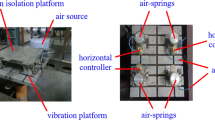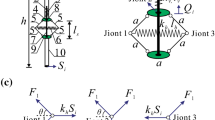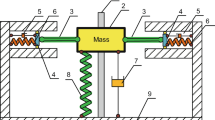Abstract
Purpose
To overcome the disadvantages that the loading capacity cannot be adjusted according to the variation of mass in traditional quasi-zero-stiffness system and invalidation of vibration isolation in low frequency region for a single air-spring, a loading-adapting quasi-zero-stiffness isolation system based on the dipteran mechanism is proposed by introducing rolling lobe air-springs coupled with friction and the imbalance of negative stiffness part.
Methods
First, the dynamic model is constructed for a single rolling lobe air-spring and the loading-adapting quasi-zero-stiffness isolation system according to the Second Newton’s Law and the Ideal Gas Law. Moreover, the Runge-Kutta method is applied to explore dynamic behaviors including the bifurcation, chaos and the co-existing periodic solutions with varying disturbing parameters. Meanwhile, the vibration isolation characteristics is investigated by employing the averaging method theoretically. Furthermore, a single air-spring and a loading-adapting quasi-zero-stiffness isolation devices are set up to verify the isolation performance experimentally.
Results
The theoretical analysis show the new bifurcation forms occurs in this system. In addition, the requirements of vibration isolation can be satisfied in low frequency region although the friction and the imbalance of stiffness are introduced in this system without affecting the isolation performance in high frequency range, illustrating the ideal robustness of the system. The experimental results also indicate a good agreement with the theoretical results obtained for the rolling lobe air-spring and the proposed loading-adapting system.
Conclusion
The findings in this work illustrates a better performance of loading-adapting quasi-zero-stiffness system than traditional quasi-zero-stiffness system and air-springs, which can provide reference for research and application about loading-adapting quasi-zero-stiffness isolation system.
























Similar content being viewed by others
References
Molyneux WG (1958) The support of an aircraft for ground resonance tests. Aircraft Eng Aerosp Technol 30:160–166
Carrella A, Brennan MJ (2007) Static analysis of a passive vibration isolator with quasi-zero-stiffness characteristic. J Sound Vib 301:678–689
Liu C, Tang J, Yu K et al (2020) On the characteristics of a quasi-zero-stiffness vibration isolator with viscoelastic damper. Appl Math Model 88:367–381
Liu C, Yu K, Tang J (2020) New insights into the damping characteristics of a typical quasi-zero-stiffness vibration isolator. Int J Nonlinear Mech 124:1–13
Yao Y, Li H, Li Y et al (2020) Analytical and experimental investigation of a high-static-low-dynamic stiffness isolator with cam-roller-spring mechanism. Int J Nonlinear Mech 126:1–13
Sun Y, Zhou J, Thompson D et al (2020) Design, analysis and experimental validation of high static and low dynamic stiffness mounts based on target force curves. Sci Int J Mech Sci 126:1–9
Deng T, Wen G, Ding H et al (2020) A bio-inspired isolator based on characteristics of quasi-zero-stiffness and bird multi-layer neck. Mech Syst Signal Process 145:1–10
Zou W, Cheng C, Ma R et al (2021) Performance analysis of a quasi-zero stiffness vibration isolation system with scissor-like structures. Arch Appl Mech 91:117–133
Li J, Cao S, Zheng J (2020) On the characteristic of a small-scale isolation mechanism with three-dimensional quasi-zero stiffness. J Mech Des N Y 142:1–9
Yan G, Zou H, Wang S, Zhao L et al (2020) Large Stroke quasi-zero stiffness vibration isolator using three-link mechanism. J Sound Vib 478:1–21
Wang K, Zhou J, Chang Y et al (2020) A nonlinear ultra-low-frequency vibration isolator with dual quasi-zero-stiffness mechanism. Nonlinear Dyn 101:755–773
Wang K, Zhou J, Ouyang H et al (2020) A semi-active metamaterial beam with electromagnetic quasi-zero-stiffness resonators for ultralow-frequency band gap tuning. Int J Mech Sci 176:1–11
Li S, Liu N, Ding H (2020) Research On a nonlinear quasi-zero-stiffness vibration isolator with a vibration absorber. Sci Prog 103:1–18
Cao Q, Xiong Y, Wiercigroch M (2013) A novel model of dipteran flight mechanism. Int J Dyn Control 1:1–11
Cao Q, Wiercigroch M, Pavlovskaia EE et al (2006) Archetypal Oscillator for smooth and discontinuous dynamics. Phys Rev E 74:1–5
Hao Z, Cao Q (2014) A novel dynamical model for GVT Nonlinear supporting system with stable-quasi-zero-stiffness. J Theor App Mech-Pol 52:199–213
Yang T, Cao Q, Hao Z (2021) A Novel nonlinear mechanical oscillator and its application in vibration isolation and energy harvesting. Mech Syst Signal Process 155:1–20
Yang T, Zhou S, Fang S, Qin W et al (2021) Mathematical modeling and characteristic analysis of the vertical stiffness for railway vehicle air spring system. Appl Phys Rev 8:1–31
Yang T, Cao Q, Li Q et al (2021) A multi-directional multistable device: modeling, experiment verification and applications. Mech Syst Signal Process 146:1–21
Lee SJ (2010) Development and analysis of an air-spring model. Int J Auto Tech-Kor 11:471–479
Mazzola L, Berg M (2012) Secondary suspension of railway vehicles-air-spring modelling: performance and critical issues. Proc Inst Mech Eng F J Rail Rapid Transit 228:225–241
Wong PK, Xie Z, Zhao J et al (2014) Analysis of automotive rolling lobe air-spring under alternative factors with finite element model. J Mech Sci Technol 28:5069–5081
Hung S, Hsu C, Hwang C et al (2017) Based on artificial neural network to realize K-parameter analysis of vehicle air spring system. In: IOP conference series. Earth and environmental science vol 86, pp 1–11
Renno F, Strano S, Terzo M (2017) Development and Validation of an air spring multiphysical model. Eng Lett 25:1–7
Takino Y, Shinmura H, Mihara T et al (2017) Optimization of damping effect for the air spring by the frequency dependent orifice. Mech Eng J 4:1–9
De Melo Francisco J. M. Q, Pereira AB, Alfredo B et al (2018) The simulation of an automotive air-spring suspension using a pseudo-dynamic procedure. Appl Sci 8:1–20
Chen J, Yin Z, Rakheja S et al (2018) Theoretical modelling and experimental analysis of the vertical stiffness of a convoluted air-spring including the effect of the stiffness of the bellows. Proc Inst Mech Eng D J Autom Eng 232:547–561
Yin L, Xu W, Hu Z et al (2020) Performance research and safety verification of compound structure air-spring. Adv Mech Eng 12:1–14
Zhang Z, Wang J, Wu W et al (2020) Semi-active control of air suspension with auxiliary chamber subject to parameter uncertainties and time-delay. Int J Robust Nonlinear 30:7130–7149
Jiang Y, Song C, Ding C et al (2020) Design of magnetic-air hybrid quasi-zero-stiffness vibration isolation system. J Sound Vib 477:1–15
Xu L (2020) Theoretical modeling of the vertical stiffness of a rolling lobe air-spring. Sci Prog 103:1–21
Xu L (2020) Mathematical modeling and characteristic analysis of the vertical stiffness for railway vehicle air spring system. Math Probl Eng 2020:1–12
Acknowledgements
The authors acknowledge the support from the major project of Natural Science Foundation of China under Grant No.11732006, and the CALT Foundation of Beijing Institute of Structure and Environmental Engineering (CALT201808).
Author information
Authors and Affiliations
Corresponding author
Ethics declarations
Conflict of Interest
The authors declare that they have no conflict of interest.
Additional information
Publisher's Note
Springer Nature remains neutral with regard to jurisdictional claims in published maps and institutional affiliations.
Rights and permissions
About this article
Cite this article
Zhang, X., Cao, Q., Qiu, H. et al. Dynamic Analysis of a Loading-Adapting Quasi-Zero-Stiffness Isolation System Based on the Rolling Lobe Air-Springs. J. Vib. Eng. Technol. 10, 3207–3225 (2022). https://doi.org/10.1007/s42417-022-00552-6
Received:
Revised:
Accepted:
Published:
Issue Date:
DOI: https://doi.org/10.1007/s42417-022-00552-6




